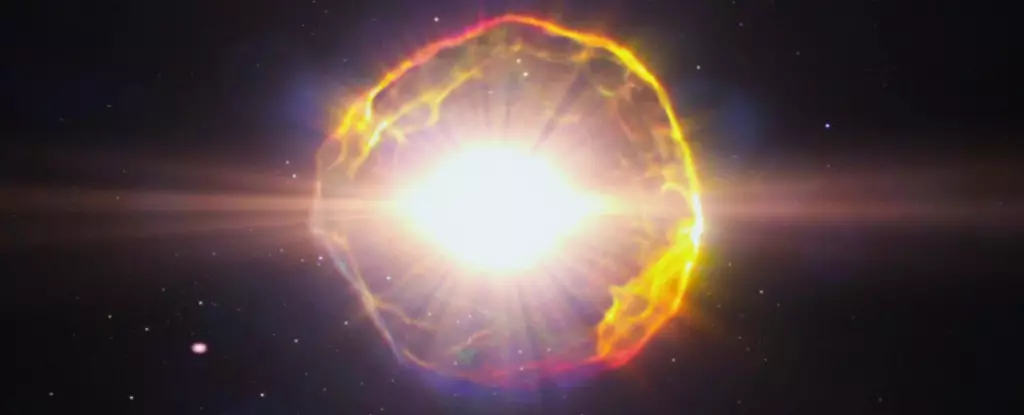In the grand cosmic theater, supernovae serve as some of the most spectacular and destructive performances in the universe. These colossal explosions signify the death throes of massive stars, those that delight in consuming their fuel rapidly—often in just a few million years. As they exhaust their life-sustaining hydrogen and helium, these stars traverse a tumultuous path that concludes in a brilliant flash of light and energy. This researcher-led analysis, spearheaded by Alexis Quintana from the University of Alicante, ventures into the ramifications of supernovae’s proximity to Earth, alluding to a deep interplay between cosmic forces and terrestrial life.
Our planet has undergone five mass extinction events—periods when life was dramatically reduced, often with over 75% of species disappearing in relatively swift timescales. The Late Ordovician and Late Devonian periods, occurring approximately 445 million and 372 million years ago respectively, represent two such formidable epochs. Now, new research suggests that distant cosmic events—the catastrophic yet beautiful supernovae—could have played an essential role in depleting Earth’s biodiversity during these critical junctures in our planet’s history.
The Case for Cosmic Accountability
It is one thing to know that a supernova is a cataclysmic phenomenon of cosmic scale, but quite another to establish its influence on Earth’s intricate tapestry of life. Researchers, including astrophysicist Nick Wright from Keele University, have begun collating evidence that links historical extinctions with cosmic events. By meticulously calculating the supernova rate in the Milky Way and recognizing its potential overlaps with Earth’s mass extinction timelines, they have constructed a compelling narrative that posits supernovae could be unusually influential agents in shaping the history of life on Earth.
Quintana’s team conducted a census of massive OB-type stars within a close radius, illuminating the notion that there are periodic “supernova factories” in our galactic neighborhood. By counting over 24,000 of these luminaries, they determined a supernova rate that whispers the possibility of catastrophes occurring relatively nearby. Specifically, their calculations estimate 2.5 OB supernovae per billion years could occur within just 65 light-years from our solar system—this frequency corresponds closely with the timing of the Ordovician and Devonian extinction events.
The Detrimental Impact of Supernovae on Earth’s Environment
The significance of a nearby supernova may be grossly underappreciated. Should a massive star explode within a certain proximity, it unleashes a barrage of energy and radiation capable of wreaking havoc on our planet’s atmosphere. Notably, the intense gamma rays emitted could deplete the ozone layer, allowing an influx of ultraviolet radiation to bombard the surface. Such an ecological upheaval would likely trigger a cascading series of disasters, disrupting food chains and resulting in widespread extinction.
The Ordovician and Devonian extinctions were marked by significant ozone depletion. The potential alignment of these events with supernova explosions raises critical questions about whether our planet is subject to sudden and unpredictable cosmic forces that can change the fabric of terrestrial life, as we know it. Furthermore, given the vast distances between stars, the likelihood of a supernova within an extensive temporal window remains daunting yet fascinating.
Current Cosmic Safety and Future Risks
For all the apprehension surrounding supernovae, we, fortunately, remain insulated from immediate cosmic threats. Despite neighboring red giants such as Antares and Betelgeuse inching ever closer to their inevitable demise, both reside hundreds of light-years away—safeguarding Earth from their explosive fates for the foreseeable future. Nevertheless, as researchers analyze these celestial patterns and relationships, it becomes increasingly evident that while current conditions are stable, the cosmic environment remains rife with dangers.
Asteroids or massive volcanic eruptions could still present significant threats, emphasizing that extinction isn’t merely a product of an alien explosion. Rather, it serves as a reminder of life’s fragility in the face of vast and unpredictable forces—both near and far. As Earth continues on its journey through the universe, the dance between cosmic antipathies and terrestrial existence looms large, leaving us to ponder our place amid the stunning yet volatile cosmos.
In understanding the cosmic forces that may have shaped Earth’s history, we amplify our appreciation for the intricate web of life on our planet. It begs the question: what other unknown variables could influence our future? As much as we spotlight cosmic threats, they remind us of the unpredictable and often harsh realities of existence on a dynamic and ever-changing Earth.


Leave a Reply